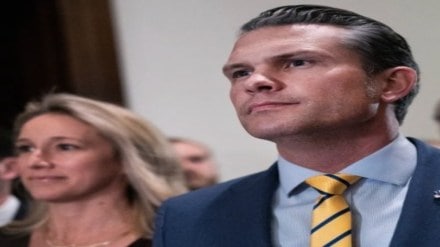US Defense Secretary Pete Hegseth, on March 15, allegedly texted the start time and other details of a planned killing of a Houthi militant in Yemen, according to a screenshot released by The Atlantic on Wednesday. The texts reportedly included imminent waves of US airstrikes.
Hegseth has denied sharing war plans, despite the backlash facing President Donald Trump’s administration for allegedly including The Atlantic‘s editor-in-chief Jeffrey Goldberg in a Signal group chat with Trump’s top national security advisers.
“So, let’s me get this straight. The Atlantic released the so-called “war plans” and those “plans” include: No names. No targets. No locations. No units. No routes. No sources. No methods. And no classified information. Those are some really shitty war plans. This only proves one thing: Jeff Goldberg has never seen a war plan or an “attack plan” (as he now calls it). Not even close. As I type this, my team and I are traveling the INDOPACOM region, meeting w/ Commanders (the guys who make REAL “war plans”) and talking to troops. We will continue to do our job, while the media does what it does best: peddle hoaxes,” read Hegseth post on X.
So, let’s me get this straight. The Atlantic released the so-called “war plans” and those “plans” include: No names. No targets. No locations. No units. No routes. No sources. No methods. And no classified information.
— Pete Hegseth (@PeteHegseth) March 26, 2025
Those are some really shitty war plans.
This only proves…
Classified information sharing
The Trump administration has maintained that no classified information was shared in the Signal chat. This assertion has left Democrats and former US officials bewildered, as targeting information is typically highly confidential ahead of military operations. Goldberg initially withheld the chat details but released them on Wednesday.
Leaked messages reveal timeline
The messages reportedly began with the title “TEAM UPDATE” and detailed the mission launch timeline:
1144 ET: Favourable weather confirmed with CENTCOM; mission launch approved.
1215 ET: The First wave of F-18s launched.
1345 ET: “Trigger-based” first strike window begins with drones also launching.
1410 ET: The Second wave of F-18s launched.
1415 ET: Drones reach targets; first bombs expected to drop.
1536 ET: Second F-18 strike begins; sea-based Tomahawk missiles launched.
The message concluded with: “We are currently clean on OPSEC. Godspeed to our Warriors.”
National security officials’ response
Senior US officials, including CIA Director John Ratcliffe, testified at a Senate hearing that national security adviser Mike Waltz set up the Signal group for unclassified coordination. Waltz later accepted responsibility, stating that no sensitive locations, sources, or war plans were disclosed. On X (formerly Twitter), Waltz downplayed the leak, emphasizing that foreign partners had already been informed of the strikes.
Defence classification dispute
Ratcliffe testified that Hegseth, as Secretary of Defense, had the authority to decide what constituted classified information. When asked if details like the timing and sequencing of attacks were classified, Director of National Intelligence Tulsi Gabbard deferred to the Defense Department and the National Security Council.
Hegseth refused to clarify whether the information in the Signal chat was declassified, simply stating, “Nobody’s texting war plans.” He expressed pride in the military operation, calling the strikes “devastatingly effective” and praised the troops’ courage and skill.
The US military has provided minimal details on the Yemen operation, including the number of strikes, targeted leaders, or even the operation’s name.
(With inputs from agencies)
